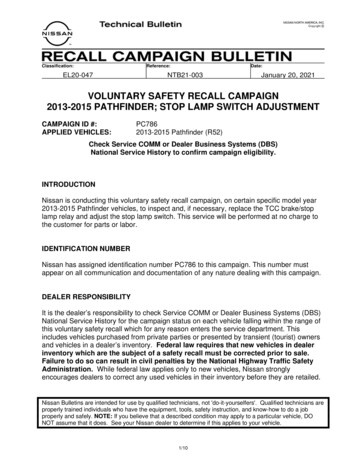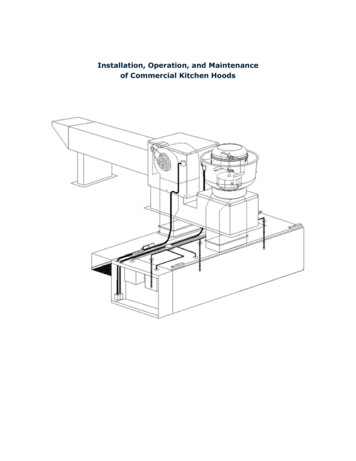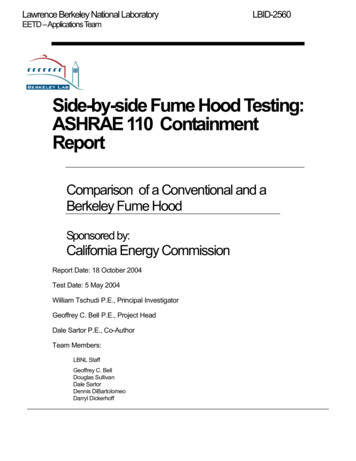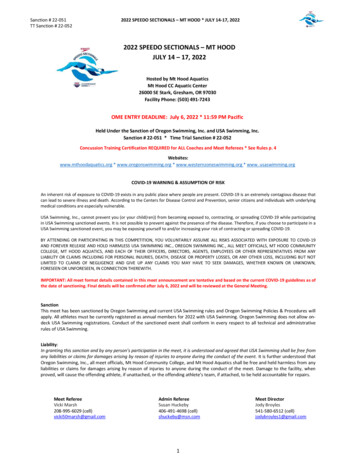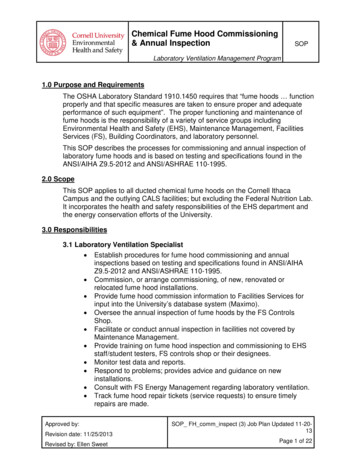
Transcription
Under the Hood of DANE Mismanagement in SMTPHyeonmin LeeSeoul National UniversityRoland van Rijswijk-DeijUniversity of Twente & NLnet LabsMd. Ishtiaq AshiqVirginia TechTaekyoung “Ted” KwonSeoul National UniversityAbstractThe DNS-based Authentication of Named Entities (DANE)is an Internet security protocol that enables a TLS connectionwithout relying on trusted third parties like CAs by introducing a new DNS record type, TLSA. DANE leverages DNSSECPKI to provide the integrity and authenticity of TLSA records.As DANE can solve security challenges in SMTP, such asSTARTTLS downgrade attacks and receiver authentication,it has been increasingly deployed surpassing more than 1 Mdomains with SMTP servers that have TLSA records. A recentstudy, however, reported that there are prevalent misconfigurations on DANE SMTP servers, which hinders DANE frombeing proliferated.In this paper, we investigate the reasons why it is hard todeploy and manage DANE correctly. Our study uses largescale, longitudinal measurements to study DANE adoptionand management, coupled with a survey of DANE operators, some of which serve more than 100 K domains. Overall,we find that keeping the TLSA records from a name serverand certificates from an SMTP server synchronized is notstraightforward even when the same entity manages the twoservers. Furthermore, many of the certificates are configuredto be reissued automatically, which may result in invalid TLSArecords. From surveying 39 mail server operators, we alsolearn that the majority keeps using CA-issued certificates,despite this no longer being required with DANE, since theyare worried about their certificates not being trusted by clientsthat have not deployed DANE. Having identified several operational challenges for correct DANE management, we releaseautomated tools and shed light on unsolved challenges.1IntroductionWith Public Key Infrastructure (PKI), Transport Layer Security (TLS) provides secure channels over the Internet. To thisend, typically, Certificate Authorities (CAs) publish certificates, and the certificates are validated hierarchically, fromthe root to the leaf certificate.Moritz MüllerSIDN LabsTaejoong ChungVirginia TechHowever, the current CA-based PKI model has a fundamental vulnerability. CAs can issue certificates for any domain name, and many CAs exist; we have no choice but totrust that all of them issue certificates appropriately. Historyshows this trust has been broken a number of times. SeveralCAs were compromised and mis-issued fraudulent certificates [17, 27]. Some CAs even issued fake certificates intentionally [28,44,57]. These incidents shook the faith in the PKImodel. Several protocols [25, 32, 35] propose mitigations forthese problems. However, none of these solutions eliminatethe root causes; the public CA model still allows any CA toissue a certificate for any domain name.1The DNS-based Authentication of Named Entities (DANE)protocol [18,30] was proposed in 2012 to augment or replacethe use of trusted public CAs. The key idea of DANE is toleverage the Domain Name System (DNS). To use DANE,a domain owner can publish his TLS server’s certificate (orpublic key) as a DNS record, called a TLSA record, to his DNSserver. This TLSA record must be signed by the DNS SecurityExtensions (DNSSEC) [4–6] to guarantee its integrity. Sinceonly a domain owner can manage DNS records of its domain,publishing TLSA records binds the domain and the certificate(or public key) of its TLS server. Thus, TLS clients can easilyauthenticate a TLS server by (i) fetching TLSA records fromthe domain’s DNS server, (ii) validating their DNSSEC signatures to check the integrity and authenticity, and (iii) checkingwhether the TLSA records are consistent with the certificatesfrom the TLS server, without relying on CAs.Due to its simple but robust security guarantees, there havebeen a number of attempts to deploy DANE for numerousweb applications such as HTTPS. However, it has never beenadopted to validate the certificates of web servers because itintroduces additional delays for browsers to fetch DNSSECand TLSA records. It is also widely known that middleboxesmay discard some DNS records such as TXT and RRSIG [34,1 The DNS Certification Authority Authorization (CAA) record [32] allows a domain name owner to specify the CAs authorized to issue certificatesfor the domain. When the record does not exist, however, it allows all CAs toissue certificates by default.
43], which hinders clients (i.e., browsers) from fetching TLSArecords for validation.Fortunately, DANE has begun to be deployed by emailservice providers for their SMTP services, because it caneffectively solve security challenges that SMTP faces suchas STARTTLS downgrade attacks [20] and SMTP service ismore tolerant to millisecond-order additional delays.A recent study [36] showed that popular email serviceproviders such as Comcast and mail.com support DANE fortheir outgoing mails. Also, the .nl and .se top-level domainsshow relatively high DANE deployments (9.7% and 38.2%each) compared to .com, .net, and .org (less than 1%). Thispractice is partially due to the fact that some registries providefinancial incentives to domains that deploy DANE [48, 54].Also, the Dutch and German governments mandate DANEfor certified mail service providers in their countries [2, 8].However, another finding in that study is that server-sidemisconfigurations often make DANE validations fail in SMTP.First, 15% of SMTP servers that deploy TLSA records are notprotected by DNSSEC that is necessary for the integrity ofDNS records. Even though TLSA records are signed, 20% ofthe corresponding DNS servers do not upload DS records totheir parent zones (so-called partial deployment). The workalso showed the second reason for misconfigurations: manySMTP servers have certificates that are not consistent withthe corresponding TLSA records; however, the reason for theinconsistency was not discussed.In this paper, we present a longitudinal and comprehensivestudy of DANE in SMTP by observing all related entitiesneeded to correctly operate DANE. We take hourly snapshotsof DNS records from all of the second-level domains from.com, .net, .org, and .se for 20 months and collect theircertificates. We also interview 39 DANE administrators tounderstand how they manage DANE and the challenges theyface for their management. Coupled with the datasets, wedraw a complete picture of the operational challenges formanaging DANE.In this paper, we make the following contributions: 99% of domains that outsource their SMTP servers manageDANE correctly. However, the invalid ratio jumps to morethan 30% when SMTP servers are self-managed. In line with [36], DNSSEC is still a problem; the majority of TLSA records (99%) that experience DNSSEC validation issues are missing DS records. We also find thatmismatches between TLSA records and corresponding certificates are prevalent (20%). We discover that many ofthese mismatched TLSA records (70%) actually match withoutdated certificates of SMTP servers, which implies thatthe mismatches came from incorrect key rollovers. Most SMTP servers (87 92%) incorrectly roll over theirkeys at least once regardless who manages the SMTP orname server; for example, more than (72 84%) of SMTPservers change their public keys and corresponding TLSArecords without considering the TTL of DNS caches. We observe that the current DANE ecosystem still relies onthe CA-based PKI model. More than 94% of SMTP serversthat deploy TLSA records use CA-issued certificates. Wealso find that this reliance causes unexpected failures inDANE management when TLSA records are not updated ontime due to automatically reissued certificates from CAs. The survey of DANE administrators shows the reasoningbehind DANE deployment and management: major reasonsfor DANE deployment are preventing STARTTLS strippingattacks and not trusting CAs; however, we still observe thatthe majority of domains that deploy DANE use CA certificates due to the compatibility with other SMTP servers notsupporting DANE.Our analysis reveals how DANE in the email system ismanaged and the reasons for mismanagement. On a more positive note, our findings demonstrate several areas of improvement where management of the DANE PKI can be automatedand audited. To this end, we publicly release all of our code,datasets and survey answers to the research community athttps://dane-study.github.iofor other administrators and researchers to reproduce andbenefit from our work.2BackgroundDNS and DNSSEC DNS associates various information(e.g., A records, MX records) with domains. DANE uses DNSto store the binding information between an identity of anentity and its public key. However, DNS does not providesecurity in its initial design; the integrity of DNS records isnot guaranteed, which makes DNS vulnerable to attacks likeDNS spoofing [11, 51]. Thus, the DNS Security Extensions(DNSSEC) [4–6] were proposed to provide the authenticationand integrity of DNS records. For this purpose, three newDNS records were introduced: DNSKEY records contain public keys used to sign DNSrecords. RRSIG records contain a digital signature of DNS recordsgenerated by the private keys corresponding to public keysin DNSKEY records. DS records contain a digest of DNSKEY records, which areuploaded to the parent DNS zone to form a chain of trust.Along with the new records, a domain now has three validation states [5]: (1) secure where a domain is equippedwith all cryptographically correct DNSSEC-related recordsin the above, (2) insecure where a domain is unsigned ordoes not have a chain of trust (i.e., absence of DS records),and thus cannot be verified regardless of DNSKEYs (or RRSIGs)
records, (3) bogus where a domain has a chain of trust, but itsDNS records are cryptographically invalid. A prior study [12]found that missing DS records are a common mistake amongmany DNS operators by showing that 30% of .com, .org, and.net domains with DNSKEYs do not have the correspondingDS records.TLSA records DANE uses TLSA records to provide information that can verify the certificate of an application runningon the domain. There can be multiple applications running onthe same domain with different port numbers, and thus a TLSArecord represents a port number, a protocol (i.e., TCP or UDP),and a base domain. For example, to request a TLSA record foran SMTP server of which the MX record is mail.foo.com, thederived domain must be 25. tcp.mail.foo.com. A TLSArecord consists of four fields: Certificate Usage specifies how to verify certificates(or public keys) from TLS servers (e.g., SMTP server withSTARTTLS). There are 4 usages depending on whose certificate is used (TA/EE) and whether PKIX validation isrequired (PKIX/DANE). The first two usages allow certificates from trusted CAs. Thus, a TLS server must provide acertificate chain that passes PKIX validation using root certificate stores. (i) PKIX-TA (Certificate Usage 0) allowsusing a root or intermediary CA’s certificate. (ii) PKIX-EE(Certificate Usage 1) allows using leaf certificates issued by trusted CAs. In contrast, the next two usages donot require PKIX validation. (iii) DANE-TA (CertificateUsage 2) allows using any certificate of a root or intermediate trust anchor (TA). Thus, a server must provide acertificate chain, including a TA’s (possibly self-signed)certificate, which can verify the server’s leaf certificate.(iv) DANE-EE (Certificate Usage 3) allows using leafcertificates that can be self-signed; The DANE RFC [18]recommends using DANE-TA and DANE-EE since PKIX CAsoffer no additional security for DANE in SMTP. Selector specifies whether the entire certificate or onlythe public key will be selected as Certificate AssociationData. Matching Type specifies how to represent the selectedcertificate part. The original value, SHA-256 hash, or SHA512 hash of the selected data can be used. Certificate Association Data contains the processeddata depending on the above fields.SMTP and STARTTLS The Simple Mail Transfer Protocol (SMTP) is a standard for email transmissions. However,SMTP has no security features in its initial design; for example, it sends emails in cleartext (no confidentiality). TheSTARTTLS extension [29] was proposed to transfer emailssecurely by using a TLS connection. An SMTP server cansend the STARTTLS command in cleartext during the SMTPconnection setup to express its TLS support to the client.Figure 1: DANE management cases are classified depending on who manages the SMTP server and the name server.(a) SMTP server is outsourced (SO), (b) SMTP server is selfmanaged but name server is outsourced (SSDO), and (c) bothSMTP server and name server are self-managed (SSDS). Notethat the name server that serves the TLSA record is also outsourced if the SMTP server is outsourced.However, this has two main security problems: First, as theSTARTTLS command is sent as cleartext, it is vulnerable todowngrade attacks to prevent TLS negotiation by stripping thecommand [20]. Second, the STARTTLS standard [29] doesnot define what to do when the STARTTLS certificate is notvalid, thus making many TLS clients not even attempt to validate the certificate [20]. With DANE, such downgrade attackscan be mitigated since the presence of TLSA records for anSMTP server are an explicit signal of STARTTLS support.2How to deploy DANE SMTP The key elements for DANEare a TLSA record and its corresponding certificate. For successful DANE deployment, an SMTP server must take threesteps. First of all, the base domain that serves TLSA recordsmust have all necessary and correct DNSSEC records, makingits validation status secure. Second, it must have a certificate, which is provided through an SMTP connection; thecertificate may be self-signed or signed by another signingcertificate. Third, it has to generate a TLSA record matchedwith the certificate; depending on the Certificate Usage,the administrator may want it to be matched with the signingcertificate (in case of DANE-TA or PKIX-TA usage) or matchedwith the leaf certificate (in case of DANE-EE or PKIX-EE usage).Where to deploy DANE SMTP At first glance, deployingDANE for an SMTP server seems straightforward becausewhat the domain owner needs to do is to keep its certificateand TLSA record consistent.However, it can become a bit tricky when the certificateand its corresponding TLSA record are managed by two different entities; domain owners may run both SMTP servers and2 Note that a domain serving TLSA records has to be DNSSEC-signed tosupport DANE. Thus, when TLSA records are not available in a given domain,the proof of non-existence such as NSEC and NSEC3 must be provided. Thismakes it impossible for man-in-the-middle attackers to simply drop the TLSArecords for downgrade attacks.
name servers by themselves, but they can also choose to outsource their management to a popular email hosting provider(for their SMTP servers) and/or an external DNS operator (fortheir name servers). Thus, in practice, a domain owner hasthree options to deploy and manage DANE as illustrated inFigure 1.First, a domain owner (e.g., example.com) may choose apopular email hosting provider (e.g., one.com) to outsourcethe SMTP server (labeled as SO). Typically, this is doneby serving an MX record that delegates to an email hostingprovider (e.g., mx1.one.com) such asmx.example.com 600 IN MX 10 mx1.one.com.Even though the MX record is served from the name server thatthe base domain name uses, the TLSA record will be fetchedfrom the name server managed by the hosting provider because a TLSA record is bound to an MX record. Thus, whena domain outsources its email services to a DANE-enabledSMTP hosting provider, the provider manages both the certificate and its TLSA record. Thus, choosing a popular emailhosting provider that can deploy TLSA records is an easy andeffective way to support DANE. However, domain ownerslose control over managing DANE because they neither manage a certificate nor TLSA records.Second, domain owners may run and manage their SMTPservers by themselves. For their name servers, they can either(1) outsource to a popular DNS operator such as Cloudflare ortheir registrar’s default name server (labeled as SSDO) or (2)manage it by themselves (labeled as SSDS). In the first case, adomain owner has the responsibility to give the outsourcingDNS operator the correct TLSA record, which matches withthe STARTTLS certificate that is used to encrypt the SMTPconnection. Thus, it might be problematic if the domain owners are not familiar with how to generate TLSA records (whenthey update their certificates) or how to give the generatedTLSA records to their outsourcing DNS operators since mismatched TLSA records result in DANE validation failures.Furthermore, a recent study [13] showed that not all registrarssupport DNSSEC when the domain owners themselves arethe DNS operator, making it impossible to deploy DANE dueto missing DS records.Why DANE validation fails In general, validating a TLSArecord fails due to two reasons: insecure or bogus DNSSEC: DANE validation mandatescorrect DNSSEC deployment. When a DANE-validatingclient finds a TLSA record to be insecure, it ignores theTLSA record and concludes that the SMTP server does notsupport DANE, which brings all of the STARTTLS vulnerabilities back.3 When the TLSA record is determined to be3 There is a debate whether we have to regard an insecure TLSA recordas an invalid TLSA record or not [19]; as DANE mandates full DNSSECdeployment and a validator considers insecure TLSA records unusable, weregard it as an invalid TLSA record. For clarity, however, we also providebogus, the client is expected to abort the SMTP connectionimmediately. Mismatched TLSA records: this happens when the certificateand its corresponding TLSA record do not match. A previousstudy [36] found that about 4% of TLSA records could notbe validated due to such a mismatch, but the root causeswere not investigated, which motivates this paper.3Related WorkIn this section, we discuss related studies about security protocols for SMTP encryption and the DANE ecosystem.SMTP encryption SMTP does not encrypt its messagesitself. Thus, the STARTTLS extension [29] was first introduced for email encryption. Several studies [20, 26, 31, 56]reported that STARTTLS is widely deployed. However, theyalso found widespread mismanagement of STARTTLS; 70%of the collected STARTTLS certificates cannot be authenticated due to misconfigurations. This is somewhat expectedbecause STARTTLS does not specify what to do for invalidSTARTTLS certificates. Recently, Poddebniak et al. [50] alsorevealed security vulnerabilities of STARTTLS such as command injection and credential stealing in SMTP, POP3 [42]and IMAP [10] protocols, which are largely due to additionalbut vague negotiation processes. To overcome these limitations, MTA-STS was also proposed to authenticate emailservers and encrypt email messages [41]. Compared to DANE,it is simpler to deploy MTA-STS by leveraging TXT records.However, it is still vulnerable to MITM attacks as it does notmandate DNSSEC.Ecosystem of DANE Zhu et al. [59] measured the DANEdeployment in 2015 by focusing on SLDs of .com and .net;they found that only 997 domains out of 485k signed domainshave TLSA records; 13% of them were invalid. Recently, Leeet al. [36] focused on the deployment of DANE for SLDs withMX records in five TLDs and popular mail service providersin 2020. The paper showed a slow but gradually increasingDANE deployment rate; less than 1% of second-level domainsof .com, .net, and .org deployed TLSA records. However,.nl and .se had deployed DANE relatively aggressively dueto financial incentives from the registries. Also, they reportedthat 3.6% of TLSA records were not matched with the corresponding certificates, thus making them invalid. However,they could not find the root causes.Considering DANE is still in the early stage, some efforts have been made to keep track of its deployment or toprovide debugging tools for DANE administrators. For example, the NL registry (SIDN) and Dukhovni et al. publishDANE deployment statistics on websites based on their active scans and present SMTP DANE validation results on athe details of the invalid reasons of a TLSA record for the rest of the paperwhenever we analyze them.
TLDMeasurementPeriod.com.net.org.se2019/07/13 6%61,8441.25%363,1920.01%MX 76%3547.91%Table 1: The number of SMTP servers and domains that haveTLSA records, and the percentage of DANE failures of SMTPservers and domains are shown as of February 12th, 2021.daily basis [52, 53]. Also, there are web-based DANE validation tools [16, 21, 22] that can help administrators debug andconfigure TLSA records.Our study extends these prior works in two ways. First,we focus on why there are prevalent cases of mismanagement in SMTP DANE by leveraging the longitudinal datasetscollected by our active measurement and the comprehensivesurvey from email service providers. Second, we find that themismanagement is mainly due to the lack of automated toolsfor key management such as key rollovers. Hence, we designand implement a prototype of automated tools for DANE keymanagement and discuss the potential operational challengesin practice.4DatasetsIn this section, we present the data we collected, and analyzehow DANE is deployed and operated.4.1DNS records and certificatesOur goal is to understand how DANE has been deployed andhow well it is managed.Daily Scans: DNS records We rely on DNS scans fromfour TLDs provided by OpenINTEL [49]: the .com, .net, and.org gTLDs and .se ccTLD. We choose three gTLDs (.com,.net, and .org) because they are the largest TLDs, and oneccTLD (.se) as Sweden shows the highest rate of DANEdeployment [36]. For each of the four TLDs, OpenINTEL firstobtains daily zone files from their registries (.com and .netfrom Verisign, .org from Public Internet Registry, .se fromInternetstiftelsen) to obtain Name Server (NS) and DelegationSigner (DS) records for all second-level domains (SLDs). Foreach of these SLDs, OpenINTEL also collects DNS recordsfrom the authoritative name servers, which include A, MX,TLSA, DNSKEYs and RRSIG records.Hourly Scans: DNS records and STARTTLS certificatesThe daily snapshots may be sufficient for understanding DANE behaviors in the SMTP protocol at a coarsegranularity, but they have two limitations. First, SMTP serverswith TLSA records do not necessarily mean that they supportDANE correctly; for example, they may not support STARTTLS, may not present certificates during the STARTTLS handshake, or may present certificates that do not match with TLSArecords, all of which make DANE validations fail. Second,the daily scan cannot capture the dynamics of DNS records ata timescale shorter than one day. We calculate the distributionof the TTL values of TLSA records across the entire dailydataset, and find that 93% of the TTLs of TLSA records areless than 1 day, which indicates that we would not capturetheir dynamics such as the changes of their certificate andTLSA records if we rely on the daily scan. To overcome theselimitations, we collect the second dataset by (1) initiating anSMTP connection using collected MX records through SMTPport number 25, (2) sending the STARTTLS command to upgrade an SMTP connection with TLS, and (3) fetching thecertificates every hour. We also collect their TLSA records andDNSSEC-related records every hour, and conduct DANE validation as well. In total, our snapshots span 20 months fromJuly 13th , 2019 to February 12th , 2021, which is summarizedin Table 1.4.2Overall DANE supportA recent study [36] reported that DANE had been increasinglydeployed around 2019 as a few large email hosting providersenabled DANE support. For example, it showed that the percentage of domains with MX records that have TLSA recordsincreased from 0.1% to 0.6% for .com domains and from0% to 38.2% for .se domains from October 2017 to October 2019.As our dataset partially overlaps with the one in [36], wecan quickly revisit the trend; Table 1 shows the number andthe percentage of domains and SMTP servers that deployedDANE. We can confirm the accelerated deployment; for example, the deployment rate increased from 0.6% to 0.97% for.com domains and from 28.41% to 41.57% for .se domainsfrom July 2019 [36] to February 2021. When validating theirTLSA records, however, we find that DANE validation failuresare widespread across the SMTP servers; for example, thepercentage of SMTP servers with invalid TLSA records is over22% when they serve domains in .com. Fortunately, the percentage of impacted domains is not as high as that of SMTPservers (e.g., 0.51% in .com domains) since the outsourcedSMTP operators support DANE without failures.To understand the potential reasons behind this widespreadunsuccessful DANE deployment, we first examine the correlation between the popularity of DANE-enabled SMTP serversin terms of the number of serving domains and their validationstatus. Figure 2 shows the CDF of the number of domainsserved by DANE SMTP servers that serve x domains in ourlatest snapshot. We make two observations.First, we notice a disparity between DANE-valid andDANE-invalid SMTP servers in terms of the number of domains that each SMTP server serves; the incorrectly config-
CDF of Domains10080604020Valid TLSA recordsInvalid TLSA records0110100100010000SMTP servers serving x Domains100000Figure 2: CDF of the number of domains served by DANESMTP servers for valid and invalid TLSA records as of February 12, 2021.ured DANE SMTP servers that serve only a single domainname take up 45% of the total domains and the largest incorrectly configured SMTP server serves only 667 domains.On the other hand, when focusing on the DANE-valid SMTPservers, we see that 90% of DANE-valid domains are servedby popular SMTP servers that have more than 10,000 domains. It is highly likely that these domain names outsourcetheir email services to popular email hosting providers. Forinstance, one.com serves more than 600,000 domains.Recall that a name server responsible for TLSA records andan SMTP server providing the actual certificate for STARTTLS have to be managed consistently to support DANE correctly, this result may suggest that the quality of DANE management could be different depending on the two entitiesthat manage the name server and SMTP server, respectively.Hence, to better understand why and how DANE validationfails, we now turn our attention to examine who manages DNSand SMTP servers for domains that support DANE SMTP.55.1DANE Quality vs. Managing EntityDetermining Managing EntitiesIdentifying whether a domain name outsources a name server(for TLSA records) or an SMTP server (for email service overSTARTTLS) is not straightforward because the only publicly available information is its DNS records such as MX,NS, TLSA and their A records. One possible approach is toleverage WHOIS, but there are several challenges. First, adomain name, its MX records and NS records can be differentfrom one another when the domain name outsources eitherthe SMTP server or name server or both. Thus, we have tocollect all registrar information of each domain name, MXand NS records, but the WHOIS infrastructure is heavily ratelimited and notoriously inconsistent [37]. Moreover, manydomains are registered through privacy-preserving servicesthat hide domain registrant information such as email addressand name, which makes it challenging to identify whether thedomain names (i.e., the RDATA fields in MX and NS records)are owned by the same entity [9].To overcome these challenges, we apply two techniques.We first focus on the popularity of the MX or NS records ofdomains. Our high-level intuition is that the MX records orNS records that map many domains such as more than 50domains are highly likely to be email hosting providers (forMX records) or external DNS operators (for NS records). Ingeneral, popular email hosting providers and external DNSoperators manage multiple NS records and MX records with thesame SLDs, respectively. For instance, the RDATA fields in NSrecords are mx[1-4].one.com. Thus we first group the SLDsof MX records and NS records, respectively, and check whethereach domain name uses popular SMTP or name servers. Thisreveals that 1,193,961 (96.6%) domains rely on email hostingproviders and 1,210,413 (97.9%) domains outsource DNSservers; each of these email hosting providers and outsourcedDNS servers serves at least 50 domains. This confirms ourfindings in Figure 2 that the majority of domains with TLSArecords are served by popular SMTP servers.However, we notice that this finding is not enough to identify which domains outsource their SMTP servers. We findsome corner cases where email hosting providers assign aunique MX record to their customers, but each of the MX recordsis mapped to the same IP address of the SMTP servers managed by the email hosting providers. A prominent example isAntagonist, which assigns a unique MX record to their customers such as mail.foo.com and mail.bar.com for theirtwo customers, foo.com and bar.com. However, we find thatall of their MX records are mapped to the same set of IPaddresses from the same set of name servers managed byAntagonist4 . This indicates that they outsource their SMTPservers to Antagonist. Thus, to prevent them from being misclassified as self-managed domains, we also group the MXrecords by their resolved IP address, which are classified asoutsourced if the number of domains relying on the sameIP address is over 50. This gives us an extra 20,707 (1.7%)domains that are found to outsource their SMTP servers.Identifying self-managed domains is not straightforwardbecause unpopular MX or NS records do not necessarilymean that they manage their own SMTP servers or nameservers. To identify them accurately, we focus on the domains that share the same
keys at least once regardless who manages the SMTP or name server; for example, more than (72 84%) of SMTP servers change their public keys and corresponding TLSA records without considering the TTL of DNS caches. We observe that the current DANE ecosystem still relies on the CA-based PKI model. More than 94% of SMTP servers



